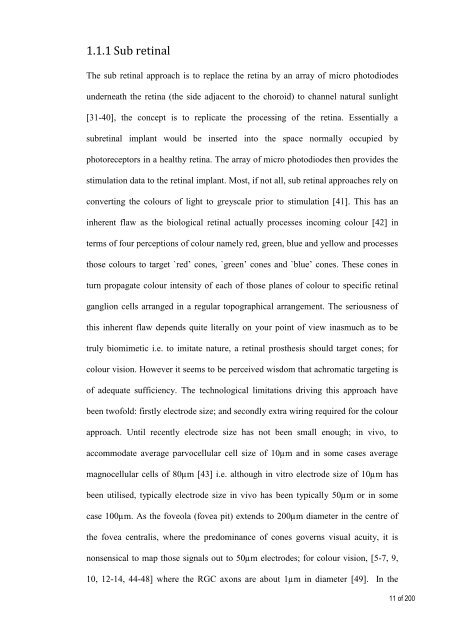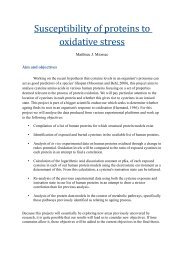Retinal Prosthesis Dissertation - Student Home Pages
Retinal Prosthesis Dissertation - Student Home Pages
Retinal Prosthesis Dissertation - Student Home Pages
Create successful ePaper yourself
Turn your PDF publications into a flip-book with our unique Google optimized e-Paper software.
1.1.1 Sub retinal<br />
The sub retinal approach is to replace the retina by an array of micro photodiodes<br />
underneath the retina (the side adjacent to the choroid) to channel natural sunlight<br />
[31-40], the concept is to replicate the processing of the retina. Essentially a<br />
subretinal implant would be inserted into the space normally occupied by<br />
photoreceptors in a healthy retina. The array of micro photodiodes then provides the<br />
stimulation data to the retinal implant. Most, if not all, sub retinal approaches rely on<br />
converting the colours of light to greyscale prior to stimulation [41]. This has an<br />
inherent flaw as the biological retinal actually processes incoming colour [42] in<br />
terms of four perceptions of colour namely red, green, blue and yellow and processes<br />
those colours to target `red’ cones, `green’ cones and `blue’ cones. These cones in<br />
turn propagate colour intensity of each of those planes of colour to specific retinal<br />
ganglion cells arranged in a regular topographical arrangement. The seriousness of<br />
this inherent flaw depends quite literally on your point of view inasmuch as to be<br />
truly biomimetic i.e. to imitate nature, a retinal prosthesis should target cones; for<br />
colour vision. However it seems to be perceived wisdom that achromatic targeting is<br />
of adequate sufficiency. The technological limitations driving this approach have<br />
been twofold: firstly electrode size; and secondly extra wiring required for the colour<br />
approach. Until recently electrode size has not been small enough; in vivo, to<br />
accommodate average parvocellular cell size of 10µm and in some cases average<br />
magnocellular cells of 80µm [43] i.e. although in vitro electrode size of 10µm has<br />
been utilised, typically electrode size in vivo has been typically 50µm or in some<br />
case 100µm. As the foveola (fovea pit) extends to 200µm diameter in the centre of<br />
the fovea centralis, where the predominance of cones governs visual acuity, it is<br />
nonsensical to map those signals out to 50µm electrodes; for colour vision, [5-7, 9,<br />
10, 12-14, 44-48] where the RGC axons are about 1µm in diameter [49]. In the<br />
11 of 200
















